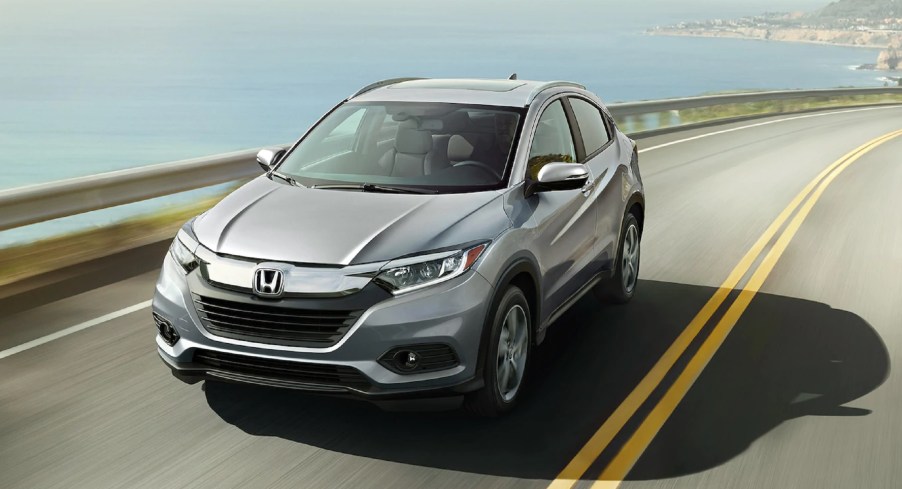
This Honda SUV Can Struggle To Meet Its EPA Fuel-Efficiency Claims
There are a number of fuel-efficient vehicles available in Honda dealerships, including some SUVs (well, crossovers). But just because a vehicle has a good EPA fuel economy rating, that doesn’t mean it can easily achieve it in the real world. Such is the case with the Honda HR-V.
The Honda HR-V is an inconsistently-efficient SUV

The Honda HR-V is the Japanese automaker’s smallest SUV. But its powertrain may actually be underpowered even for its relatively small dimensions. It’s an issue that Autoblog, Car and Driver, and Motor Trend have repeatedly noted.
For 2021, the Honda HR-V carries on with a 1.8-liter four-cylinder engine linked to a CVT, NADAGuides reports. The subcompact Honda SUV comes standard with front-wheel drive, though AWD is available. The 1.8-liter engine makes 141 hp and 127 lb-ft, which gives the FWD model an 8.6-second 0-60 mph time, Car and Driver reports. Going with AWD adds weight, and increases the 0-60 mph time to 9.5 seconds, Car and Driver reports.

Admittedly, Honda HR-V buyers likely aren’t interested in raw acceleration, but practicality and fuel efficiency. And on paper, it excels at the latter. The EPA rates the FWD Honda HR-V at 28 mpg city and 34 mpg highway. The AWD models are rated at 27 mpg city and 31 mpg highway, FuelEconomy.gov reports.
However, the subcompact Honda SUV doesn’t always prove to be this fuel-efficient in the real world. MT’s long-term FWD HR-V saw 27.8 mpg in combined driving. Not only is this less than the combined EPA rating of 30 mpg, but it’s also less than MT’s ‘Real MPG’ test claims the HR-V can see.
Both the FWD and AWD Honda HR-Vs Car and Driver tested also under-delivered in fuel economy. The former saw a combined 26 mpg, and the latter got 30 mpg on the highway.
On the other hand, another AWD Honda HR-V Car and Driver tested saw 28 mpg in combined driving. So, it can roughly match its EPA fuel economy ratings, just not easily.
Why does the Honda HR-V’s real-world fuel economy vary so much?
It’s worth pointing out that the Honda HR-V isn’t alone in seeing real-world efficiency that’s different from the EPA ratings. It’s an issue that also affects EVs like the Porsche Taycan.
There are several potential reasons for the HR-V’s inconsistent fuel economy. One is that, like every vehicle, the ratings are based on standardized tests, Edmunds explains. Cars are placed on dynamometers and run at different speeds to simulate city and highway driving conditions, Car and Driver explains. According to Consumer Reports, the EPA’s test procedures have gotten better at accurately recreating real-world conditions. But they’re still not 100% accurate.

The other reason may be the Honda HR-V’s engine. True, small engines are generally more fuel-efficient than large ones, especially in EPA testing, Autotrader explains. However, a small engine in a relatively-large vehicle has to work harder than a larger engine in a smaller vehicle. The Honda Fit has the same powertrain as the HR-V, but the smaller hatchback is significantly more fuel-efficient, Car and Driver reports.
It’s also why turbocharged small-displacement engines often fail to reach their rated fuel economies on real roads, the Chicago Tribune explains. The drivers have to rev and work these engines hard to get meaningful acceleration, and thus burn more fuel.
Can something be done about this?
That’s not to say the Honda HR-V can’t be fuel-efficient or get mileage within the ballpark of the EPA’s ratings. It just takes a bit of prep-work.
There are a few things you can do to improve your car’s fuel economy, whether you drive a Honda SUV or something else. First, don’t stomp on the gas pedal. In fact, drive with smooth, gradual acceleration, Motor1 reports. That also allows you to better-gauge the flow of traffic, and use your brake pedal less, which also improves mileage.
Secondly, remove any excess weight in or around your car, CR explains. Especially if it’s a large object, like a bike rack. More weight and/or more aerodynamic drag means your engine has to work harder and thus burn more fuel.
Also, make sure your tires are inflated to the correct pressure. And if you haven’t gotten an alignment recently, it might be time to do so. Improper inflation and misalignment affect how tires wear and put further stress on the engine.
Follow more updates from MotorBiscuit on our Facebook page.


